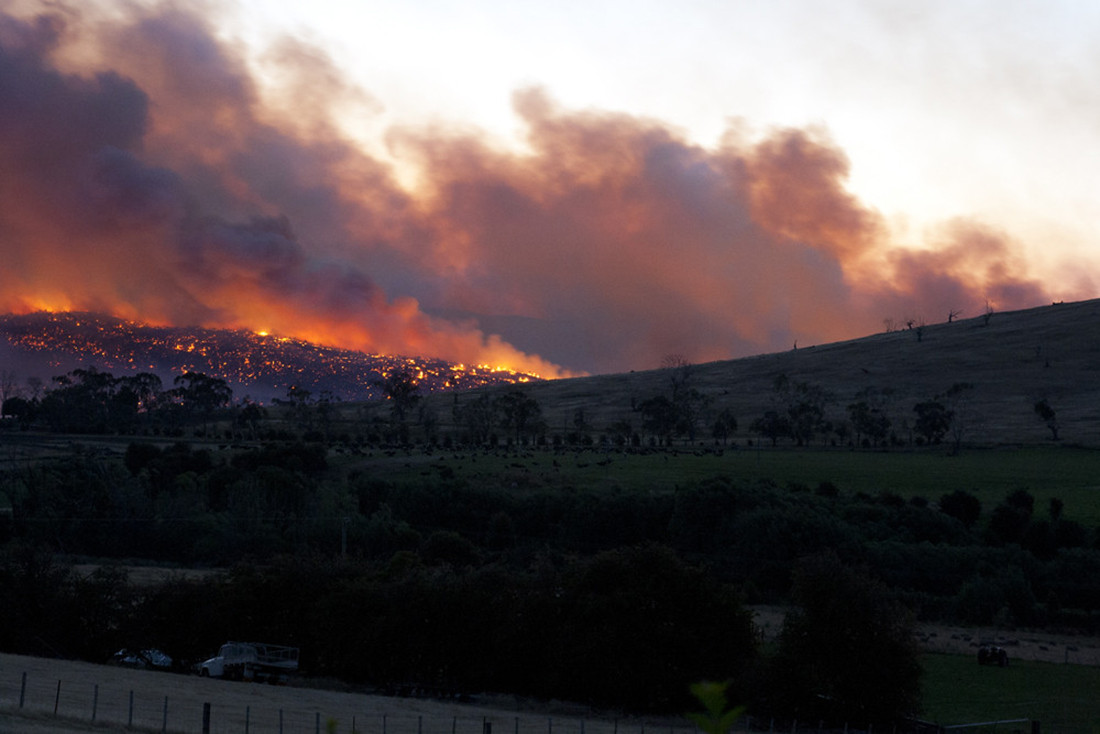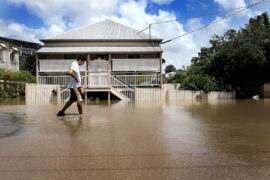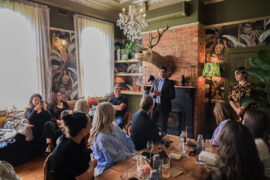What happens when the risk of fire makes regional life completely uninsurable? We may be about to find out.

January 8th, 2020
The bushfire crisis in Australia is unprecedented, burning all over the country at a scale never before seen. Our longer bushfire seasons and drier seasons have given us the horror summer which science predicted a decade ago. So when will it be time to talk about how life in regional Australia has become a ticking time bomb?
Regional Australia is where our food is grown. It’s our places of natural wonder. It covers literally hundreds of this country’s First Nations.
And a lot of it is under severe threat.

Mount Macedon following the 1983 Ash Wednesday bushfires
Population management in Australia has always been a difficult topic, not least because of Australia’s less-than-excellent history of institutional racism. But the focus in recent years has been on the increasing pressure on our cities and how the combination of long-term neglect with occasional quick fixes that create exciting new problems of their own (cough, Sydney’s cracking apartment blocks, cough cough).
So, there’s been a lot of talk about ways to encourage people to move the hell out of Sydney and Melbourne. And up until now the main problem with this aim is that those cities contain almost all the high-waged jobs. As sales pitches go, “come to regional Australia where there are no jobs, low wages, few non-country music gigs, and a GP in the neighbouring town every other month” lacks a certain lifestyle allure for most established slickers of the city.
Oh yeah, and that other thing: in a lot of country towns, there’s the problem that they’re literally on fire – and a lot of them won’t be coming back.

Fire-fighting truck of the South Australian Country Fire Service pictured during the Bushfires of 2005
The cost of the bushfires to our nation’s insurers, according to the Guardian, has been estimated at around $700 million and rising. And while the Federal Government can afford to be cagey about climate change and whether or not what we’ve seen in the last few months is the terrifying new normal, the insurance industry isn’t going to be that sanguine about reality. What happens when they decide that towns in fire zones are a risk too far?
Underinsurance is already a massive and growing problem in Australia generally, with The Conversation estimating that 65 per cent of people with home insurance couldn’t expect it to actually cover the replacement of their house.
And that’s among people who are actually insured: in some places people have decided it’s an expense they can’t handle. There are estimates that around 40 per cent of residents in northern Western Australia are uninsured due to the exorbitant cost in a region that is regularly battered by cyclones and floods. And for those who are paying their premiums, California’s insurers alerted some 350,000 policyholders that their coverage wouldn’t be renewed after last year’s fires and it’s unlikely their Australian counterparts are going to be much more accommodating.
So that’s the situation facing our regional towns – but given the sprawling nature of Australia’s metropolises our cities are still at risk.

The fire-ravaged Blue Mountains and the Adelaide Hills are still in metropolitan regions, and new suburbs being built in an attempt to provide affordable housing and keep the building industry afloat are on the urban fringes, often surrounded by bushland – and few of those young families moved there hoping to spend months each year defending their increasingly uninsurable neighbourhoods.
So maybe this is an excellent opportunity for some ambitious thinking about what a rebuilt Australia might look like and how we might like to change how we live in this wide brown smoky land. It’s time for some brave, inventive and out-of-the-terribly-flammable-box thinking.
And we’d better do it quickly, because after 40 years of climate denial it appears that nature’s sick of waiting for us.
Editors Note: We’d like to make our readers inside the industry aware of Architects Assist, Over 100 Australian architecture studios have combined to provide free design and planning services to the victims of the current Bushfire crisis. If you’re in a position to help we encourage you to get in touch with them, for more information please visit their site.
We encourage all our readers to donate to groups helping to fight the fires and support victims. Groups like the Red Cross, the NSW Rural Fire Service, the Victorian Bushfire Appeal and WIRES.
INDESIGN is on instagram
Follow @indesignlive
A searchable and comprehensive guide for specifying leading products and their suppliers
Keep up to date with the latest and greatest from our industry BFF's!

A curated exhibition in Frederiksstaden captures the spirit of Australian design

The undeniable thread connecting Herman Miller and Knoll’s design legacies across the decades now finds its profound physical embodiment at MillerKnoll’s new Design Yard Archives.

London-based design duo Raw Edges have joined forces with Established & Sons and Tongue & Groove to introduce Wall to Wall – a hand-stained, “living collection” that transforms parquet flooring into a canvas of colour, pattern, and possibility.

David Gole, principal at leading climate-resilient design practice JDA Co., comments on the intersection between heritage and climate in architecture.

At the World Design Congress in London, a simple idea threaded through two dense days: design is not an island. It moves inside wider systems of economics, policy, finance and ecology.
The internet never sleeps! Here's the stuff you might have missed

Guests joined Cosentino for a behind-the-scenes look at The Block homes, discovering new materials and creative partnerships.

The Senior Design Director at RSHP reflects on Barangaroo South Masterplan during a visit to Sydney marking ten years since the completion of the first phase.